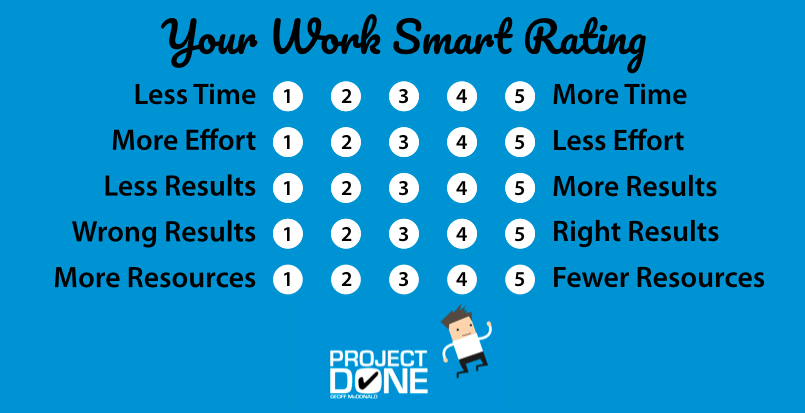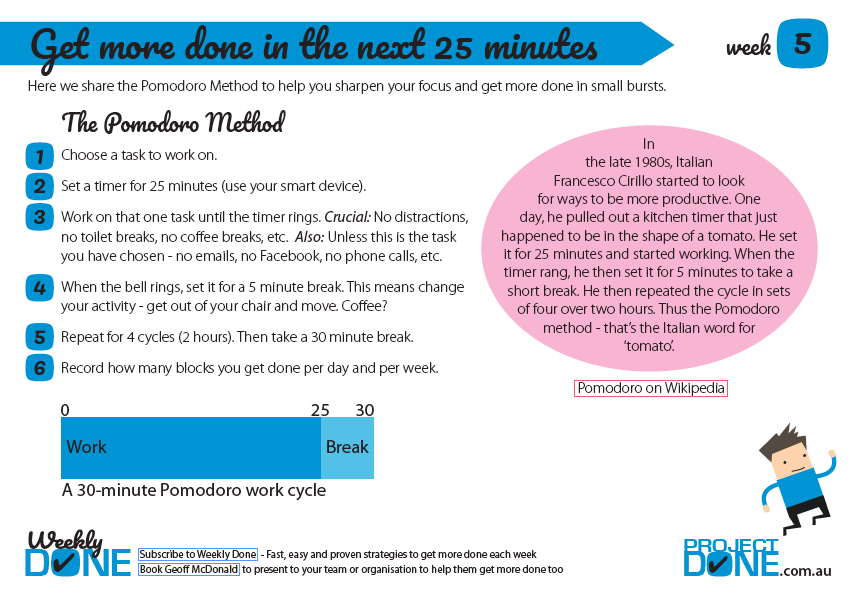
Work Smart
What’s the Pomodoro Technique and how can it help you get more done?
We’ve all been told at some point that we need to work smarter to get more work done.
But have you ever stopped to ask yourself: What does it mean to ‘work smart’?
The holy grail of productivity is to: get more of the right results done in less time with less effort and fewer resources.
For many people in organisations, this is the unspoken expectation of working smart – and being a good employee. And if you’re self-employed, the key to sleeping soundly at night is satisfied with your day.
The Work Smart Rating
Give yourself a Work Smart Rating by answering these five questions:
- I get things done in More time OR Less time
- I get more done with More effort OR Less Effort
- I produce: fewer Results OR More Results
- I produce: Wrong Results OR Right Results
- I need: More Resources OR Fewer Resources

Smart Work Results
- 0-5 – I wouldn’t employ you
- 6-10 – Room to improve
- 11-15 – Better than most
- 16-20 – Come and work for me!
Bonus: Compare yourself to a colleague who you consider is productive to give yourself a ‘smart work’ benchmark.
The Secret to Getting More done in less time
What I will share in this article has the potential to help you work smart. It’s a simple productivity system that you can learn in minutes.
But be warned. If you simply read the instructions, you might be struck by how simple it is and start to question whether the Pomodoro Technique actually works.
I’ve been using Pomodoro most days over the past three years. As a result, I have cut my work hours back from eight hours a day to six hours a day and I believe I get as much or more done than I previously did in two hours less each day. That’s the power of focus and concentration.
The Real Secret
As usual, the secret is in what is not said. The key to the Pomodoro Technique is not the time frame, not the timer you use and not even the task you choose. It’s that you choose to focus on one thing only for the duration of your work block.
This is absolutely crucial: Once you choose your task and start your timer, you will not accept any distractions, no toilet breaks, no coffee breaks, no phone calls, no email, no Facebook, no patting the dog and no cleaning up the papers on your desk.
The only exception is if this is the task you have chosen to perform – but you have to declare this before you begin. For instance, if you say you are going to do emails or make phone calls for the next 25 minutes, then naturally do that – but nothing else.
The power of this approach is that it builds your level of focus and reduces distractions. That’s the whole point of this process.
The big bonus of the Pomodoro Technique is that these are not one-off results. Like an athlete training to run faster or lift heavy things, your powers of focus and concentration will rise as you practice this work method. You are building the focus habit.
The Pomodoro Timer

Some backstory… In the late 1980s, Italian Francesco Cirillo started to look for ways to be more productive. One day, he pulled out a kitchen timer that just happened to be in the shape of a tomato. He set it for 25 minutes and started working. When the timer rang, he then set it for 5 minutes to take a short break. He repeated this cycle in sets of four over two hours. Thus the Pomodoro method – that’s the Italian word for ‘tomato’.
The Pomodoro Technique
Here are the six steps of the Pomodoro Technique:
- Choose one task to work on. Not two tasks, one only. Be specific.
- Set a timer for 25 minutes. Most of us carry a smart device and these tend to have app timers on them. Otherwise, if you have access to the Internet and a web browser, Google ‘timer’ to find one.
- Work on that one task until the timer rings.
- When the bell tolls, set it for a 5-minute break. This means changing your activity – get out of your chair and move. (You can now grab a coffee.)
- Repeat this for 4 cycles (2 hours). Then take a 30-minute break.
- Record how many blocks you get done per day and per week.
Note: The Pomodoro Technique is an intense way to work. In the beginning, you may surprise yourself by how distracted you are. And you may need to gradually build up the number of blocks you can do in a day. It took me around six months to be able to complete my now usual pattern of completing two blocks of four Pomodoro sessions each in a single day.

Also: Notice if you’re wanting to cheat on the five-minute break. That’s a sure bet that you are wound up a little fast, a bit stressed and probably anxious. Stay calm and enjoy your break – your brain will thank you for it and you’ll probably get more done as a result.
The Big Bonus of the Pomodoro Technique
There is one more thing about the Pomodoro Technique that is vital here. It’s an added bonus that may surprise and delight you.
At the end of every 25-minute block, you get to take a break. Yes, that’s the Pomodoro deal – work for 25 minutes, have a 5-minute break. Or work for four blocks and have a 30-minute break.
Neuroscience is telling us that our brains are not machines. They do not work well revving at the same pace all day. It’s much better for your energy, effort and ultimately focus and results to take regular breaks. The Pomodoro Technique has this built-in.
Let’s be clear about what a break means. According to your brain, sitting down at your desk for 25 minutes working on your laptop and then switching to Facebook for five minutes while still sitting at the same desk with the same laptop is not a break. To your brain, that’s the same activity.
A break means getting up out of your chair and doing a different activity. You need to move. You might have heard the saying ‘sitting is the new smoking’. Sitting down for long periods of time – over 30-60 minutes in a single sitting – is not good for your health.
Your break is when you stand up, walk out of your work area and make coffee, go to the toilet, or my personal favourite when I’m working at home – do the dishes or some piece of housework that would otherwise not have been done at all.
How long is a Pomodoro Technique Session?
For me, I almost always stick to the 25-minutes sessions. This works for me.
Some days this will be annoying – you will be right in the middle of your flow when your Pomodoro Timer will ring. On other days you will be looking at your clock every second hoping, wishing and praying that time was up.
I know other people who have extended their sessions to 45 minutes and even 60 minutes. By all means, explore what works for you. But remember, the point is to do a focused sprint for a short period of time, followed by a break.
If you’re not doing that then you’re not doing the Pomodoro Technique and you may not get the benefits of concentration and output that you expect.
Brain research suggests that 45 minutes is an optimum period of focus before we all need a break.
Summary: Work Smart and the Pomodoro Technique
The Pomodoro Technique is one of my favourite productivity systems that I use almost every day. Simply put, set a timer for 25 minutes and complete one activity during this time. Then take a break. It’s a powerful way to build your concentration, eliminate distractions, work smart and get more done.



